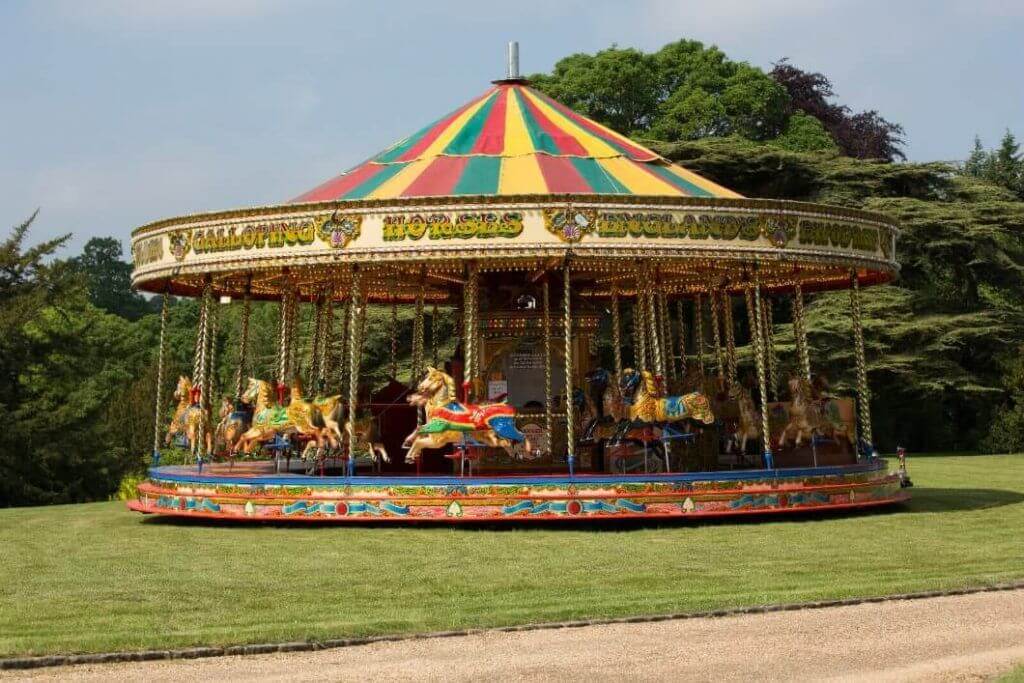The carousel was long a mainstay of funfairs and amusements parks throughout the world. As one of the first, big amusement rides, it transcended the generations and is still operating regularly today.
It was estimated that in the USA, at one point there were around 5000 carousels. Sadly when the great depression hit the number dwindled and gradually as the 70’s rolled around they kind of fell out of favour with maintenance costs making them unviable in the financial climate of the times. Numbers fell to to around 150.
Many of the carousels from the great historic manufacturers such as Dentzel and Charles Looff suddenly became more valuable for their parts than as actual rides. At auction horses from these master carvers were bringing in an average of $40,000. One example, a St Bernard went for a record $250,000.
As with many traditional skills and crafts, the art of manufacturing these works of art was in serious danger of disappearing. Fibreglass and metal carousels were still being produced for the market, and whilst still beautiful and ornate rides, weren’t the individual unique masterpieces of yesteryear.
Fortunately two friends decided that it was still possible to make a successful business with individual hand crafted rides.
Art Richie
Richie started carving in 1973. Leaving college on a Friday and opening his first business making plaques and other wooden goods the next day. One day a customer asked for a quote on carving a carousel horse, Ritchie told him around $1800 and laughed the guy couldn’t get his cheque book out quickly enough.
Dan Jones
The other founder of the company was a construction worker who had carried out repair and maintenance work on a number of historic carousels. Together their skills made a perfect complement for the initial business of restoration.
Carousel Works
In 1986 the duo formed Carousel Works. The aim was to work on existing vintage carousels, to repair and renovate them. Keeping part of the amusement industries rich history working. Their ultimate aim however was to design and build new carousels.
This dream was achieved in 1991 when their first carousel was delivered to Richland Carrousel Park in Mansfield Ohio. Becoming the first new wooden carousel to be delivered since the 1930’s. With 30 horses and 22 menagerie animals the ride was carved in the style of G.A. Dentzel,one of the all time greats in carousel history.
The lovely thing about wooden carousels carved in the traditional manner, is the variety and uniqueness of each animal. They are all individual one off carvings. Modern carousels with fibreglass horses will have used perhaps three or four different designs meaning large numbers of the horses are identical.
60 Carousels And Counting
Since then the company have delivered in excess of 60 rides around the world. They currently have 28 employees including painters and carvers. The animals are made the old fashioned way by gluing blocks of basswood together before being cut into a rough shape by machine, then hand carved into intricate works of art. Despite what people believe, the figures aren’t made from single blocks of wood, this wouldn’t be flexible enough and would crack. Instead they are anything upto 70 individual blocks glued together.
Looking at their list of clients they seemed to have cornered the market in carousels for Zoo’s!
Their designs all start the same way, with a blank sheet of paper. They are truly one of a kind, using traditional skills and craftmanship to keep alive a great tradition. Their offerings include over 160 different animals for the ride. They are happy to work with a client to create something totally new. Whether its an unusual animal for a zoo, or something specific to a corporate clients design. A couple that stand out were the chariot carved in the shape of a pile of dung being pushed by a dung beetle, and a dog food company had one cared as a bag of dog food with a puppy sticking its head out.
This customisation extends not only to the animals on the ride, but also to the decorative panels that adorn it, each ride is a work of art.
Not Everyone Is Happy
Evidently however there are some who are not happy. Their willingness to innovate and new style has drawn criticism from some of the carousel ‘purists’. Who feel that they cannot compare to the great designs from Looff, Dentzel et al. A similar reaction was encountered when car firm Bentley announced it was going to manufacture some new examples of its historic Bentley Blower model. Perhaps they feel it will devalue their investment in historic carousel horses if new ones are still being made.
The favourite quote on the subject we heard came from Bette Largent, president of the National Carousel Association. She exclaimed “We didn’t stop painting after Rembrandt died!”
With the nostalgia that’s now back in fashion, and the fact that historic carousels are fetching upwards of $1 million, the company is perfectly placed to thrive with a stunning hand crafted product at a great price.
UPDATE
Sadly since this was published, the company has sadly filed for bankruptcy. Details here…
Sources;


